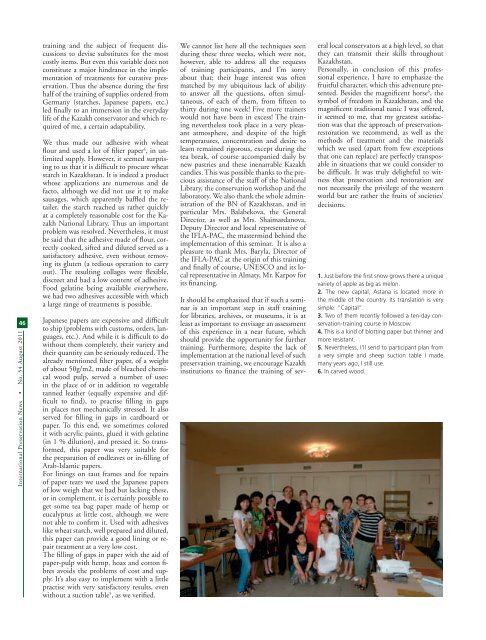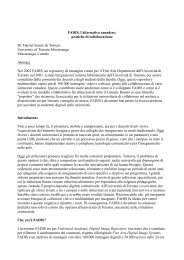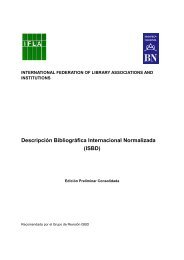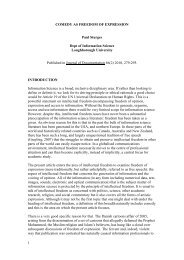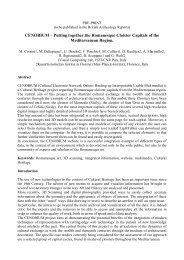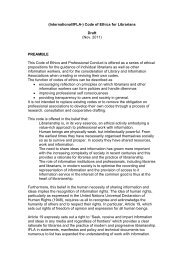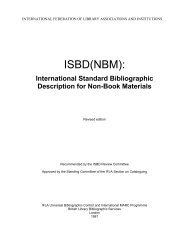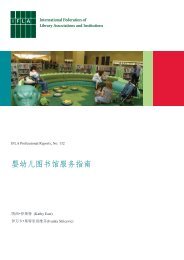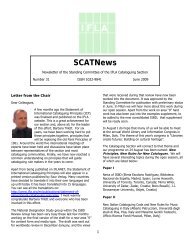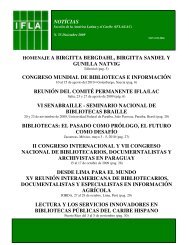N o 54 - IFLA
N o 54 - IFLA
N o 54 - IFLA
Create successful ePaper yourself
Turn your PDF publications into a flip-book with our unique Google optimized e-Paper software.
46<br />
International Preservation News • No. <strong>54</strong> August 2011<br />
training and the subject of frequent discussions<br />
to devise substitutes for the most<br />
costly items. But even this variable does not<br />
constitute a major hindrance in the implementation<br />
of treatments for curative preservation.<br />
Thus the absence during the first<br />
half of the training of supplies ordered from<br />
Germany (starches, Japanese papers, etc.)<br />
led finally to an immersion in the everyday<br />
life of the Kazakh conservator and which required<br />
of me, a certain adaptability.<br />
We thus made our adhesive with wheat<br />
flour and used a lot of filter paper 4 , in unlimited<br />
supply. However, it seemed surprising<br />
to us that it is difficult to procure wheat<br />
starch in Kazakhstan. It is indeed a product<br />
whose applications are numerous and de<br />
facto, although we did not use it to make<br />
sausages, which apparently baffled the retailer,<br />
the starch reached us rather quickly<br />
at a completely reasonable cost for the Kazakh<br />
National Library. Thus an important<br />
problem was resolved. Nevertheless, it must<br />
be said that the adhesive made of flour, correctly<br />
cooked, sifted and diluted served as a<br />
satisfactory adhesive, even without removing<br />
its gluten (a tedious operation to carry<br />
out). The resulting collages were flexible,<br />
discreet and had a low content of adhesive.<br />
Food gelatine being available everywhere,<br />
we had two adhesives accessible with which<br />
a large range of treatments is possible.<br />
Japanese papers are expensive and difficult<br />
to ship (problems with customs, orders, languages,<br />
etc.). And while it is difficult to do<br />
without them completely, their variety and<br />
their quantity can be seriously reduced. The<br />
already mentioned filter paper, of a weight<br />
of about 50g/m2, made of bleached chemical<br />
wood pulp, served a number of uses:<br />
in the place of or in addition to vegetable<br />
tanned leather (equally expensive and difficult<br />
to find), to practise filling in gaps<br />
in places not mechanically stressed. It also<br />
served for filling in gaps in cardboard or<br />
paper. To this end, we sometimes colored<br />
it with acrylic paints, glued it with gelatine<br />
(in 1 % dilution), and pressed it. So transformed,<br />
this paper was very suitable for<br />
the preparation of endleaves or in-filling of<br />
Arab-Islamic papers.<br />
For linings on taut frames and for repairs<br />
of paper tears we used the Japanese papers<br />
of low weigh that we had but lacking these,<br />
or in complement, it is certainly possible to<br />
get some tea bag paper made of hemp or<br />
eucalyptus at little cost, although we were<br />
not able to confirm it. Used with adhesives<br />
like wheat starch, well prepared and diluted,<br />
this paper can provide a good lining or repair<br />
treatment at a very low cost.<br />
The filling of gaps in paper with the aid of<br />
paper-pulp with hemp, hoax and cotton fibres<br />
avoids the problems of cost and supply.<br />
It’s also easy to implement with a little<br />
practise with very satisfactory results, even<br />
without a suction table 5 , as we verified.<br />
We cannot list here all the techniques seen<br />
during these three weeks, which were not,<br />
however, able to address all the requests<br />
of training participants, and I’m sorry<br />
about that; their huge interest was often<br />
matched by my ubiquitous lack of ability<br />
to answer all the questions, often simultaneous,<br />
of each of them, from fifteen to<br />
thirty during one week! Five more trainers<br />
would not have been in excess! The training<br />
nevertheless took place in a very pleasant<br />
atmosphere, and despite of the high<br />
temperatures, concentration and desire to<br />
learn remained rigorous, except during the<br />
tea break, of course accompanied daily by<br />
new pastries and these inenarrable Kazakh<br />
candies. This was possible thanks to the precious<br />
assistance of the staff of the National<br />
Library, the conservation workshop and the<br />
laboratory. We also thank the whole administration<br />
of the BN of Kazakhstan, and in<br />
particular Mrs. Balabekova, the General<br />
Director, as well as Mrs. Shaimardanova,<br />
Deputy Director and local representative of<br />
the <strong>IFLA</strong>-PAC, the mastermind behind the<br />
implementation of this seminar. It is also a<br />
pleasure to thank Mrs. Baryla, Director of<br />
the <strong>IFLA</strong>-PAC at the origin of this training<br />
and finally of course, UNESCO and its local<br />
representative in Almaty, Mr. Karpov for<br />
its financing.<br />
It should be emphasized that if such a seminar<br />
is an important step in staff training<br />
for libraries, archives, or museums, it is at<br />
least as important to envisage an assessment<br />
of this experience in a near future, which<br />
should provide the opportunity for further<br />
training. Furthermore, despite the lack of<br />
implementation at the national level of such<br />
preservation training, we encourage Kazakh<br />
institutions to finance the training of sev-<br />
eral local conservators at a high level, so that<br />
they can transmit their skills throughout<br />
Kazakhstan.<br />
Personally, in conclusion of this professional<br />
experience, I have to emphasize the<br />
fruitful character, which this adventure presented.<br />
Besides the magnificent horse 6 , the<br />
symbol of freedom in Kazakhstan, and the<br />
magnificent traditional tunic I was offered,<br />
it seemed to me, that my greatest satisfaction<br />
was that the approach of preservationrestoration<br />
we recommend, as well as the<br />
methods of treatment and the materials<br />
which we used (apart from few exceptions<br />
that one can replace) are perfectly transposable<br />
in situations that we could consider to<br />
be difficult. It was truly delightful to witness<br />
that preservation and restoration are<br />
not necessarily the privilege of the western<br />
world but are rather the fruits of societies’<br />
decisions.<br />
1. Just before the first snow grows there a unique<br />
variety of apple as big as melon.<br />
2. The new capital, Astana is located more in<br />
the middle of the country. Its translation is very<br />
simple: “Capital”.<br />
3. Two of them recently followed a ten-day conservation-training<br />
course in Moscow.<br />
4. This is a kind of blotting paper but thinner and<br />
more resistant.<br />
5. Nevertheless, I’ll send to participant plan from<br />
a very simple and sheep suction table I made<br />
many years ago, I still use.<br />
6. In carved wood.


